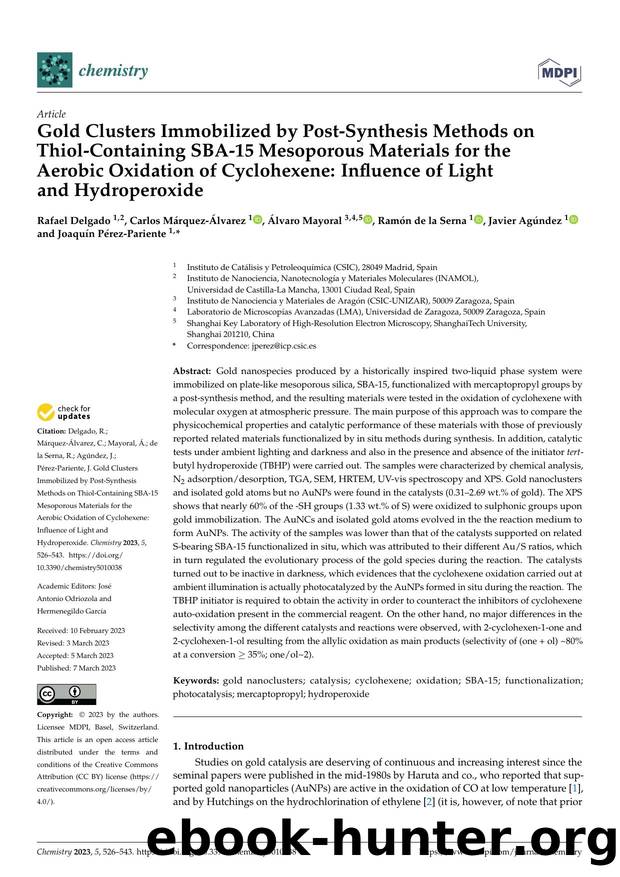Gold Clusters Immobilized by Post-Synthesis Methods on Thiol-Containing SBA-15 Mesoporous Materials for the Aerobic Oxidation of Cyclohexene: Influence of Light and Hydroperoxide by unknow

Author:unknow
Format: pdf
Tags: Gold nanospecies produced by a historically inspired two-liquid phase system were immobilized on plate-like mesoporous silica, SBA-15, functionalized with mercaptopropyl groups by a post-synthesis method, and the resulting materials were tested in the oxidation of cyclohexene with molecular oxygen at atmospheric pressure. The main purpose of this approach was to compare the physicochemical properties and catalytic performance of these materials with those of previously reported related materials functionalized by in situ methods during synthesis. In addition, catalytic tests under ambient lighting and darkness and also in the presence and absence of the initiator tert-butyl hydroperoxide (TBHP) were carried out. The samples were characterized by chemical analysis, N2 adsorption/desorption, TGA, SEM, HRTEM, UV-vis spectroscopy and XPS. Gold nanoclusters and isolated gold atoms but no AuNPs were found in the catalysts (0.31–2.69 wt.% of gold). The XPS shows that nearly 60% of the -SH groups (1.33 wt.% of S) were oxidized to sulphonic groups upon gold immobilization. The AuNCs and isolated gold atoms evolved in the the reaction medium to form AuNPs. The activity of the samples was lower than that of the catalysts supported on related S-bearing SBA-15 functionalized in situ, which was attributed to their different Au/S ratios, which in turn regulated the evolutionary process of the gold species during the reaction. The catalysts turned out to be inactive in darkness, which evidences that the cyclohexene oxidation carried out at ambient illumination is actually photocatalyzed by the AuNPs formed in situ during the reaction. The TBHP initiator is required to obtain the activity in order to counteract the inhibitors of cyclohexene auto-oxidation present in the commercial reagent. On the other hand, no major differences in the selectivity among the different catalysts and reactions were observed, with 2-cyclohexen-1-one and 2-cyclohexen-1-ol resulting from the allylic oxidation as main products (selectivity of (one + ol) ~80% at a conversion 35%; one/ol~2)., gold nanoclusters; catalysis; cyclohexene; oxidation; SBA-15; functionalization; photocatalysis; mercaptopropyl; hydroperoxide
Download
This site does not store any files on its server. We only index and link to content provided by other sites. Please contact the content providers to delete copyright contents if any and email us, we'll remove relevant links or contents immediately.
| Administration & Medicine Economics | Allied Health Professions |
| Basic Sciences | Dentistry |
| History | Medical Informatics |
| Medicine | Nursing |
| Pharmacology | Psychology |
| Research | Veterinary Medicine |
When Breath Becomes Air by Paul Kalanithi(7310)
Why We Sleep: Unlocking the Power of Sleep and Dreams by Matthew Walker(5699)
Paper Towns by Green John(4207)
The Immortal Life of Henrietta Lacks by Rebecca Skloot(3857)
The Sports Rules Book by Human Kinetics(3628)
Dynamic Alignment Through Imagery by Eric Franklin(3522)
ACSM's Complete Guide to Fitness & Health by ACSM(3490)
Kaplan MCAT Organic Chemistry Review: Created for MCAT 2015 (Kaplan Test Prep) by Kaplan(3448)
Introduction to Kinesiology by Shirl J. Hoffman(3326)
Livewired by David Eagleman(3170)
The River of Consciousness by Oliver Sacks(3019)
The Death of the Heart by Elizabeth Bowen(2939)
Alchemy and Alchemists by C. J. S. Thompson(2932)
Descartes' Error by Antonio Damasio(2772)
Bad Pharma by Ben Goldacre(2754)
The Gene: An Intimate History by Siddhartha Mukherjee(2521)
Kaplan MCAT Behavioral Sciences Review: Created for MCAT 2015 (Kaplan Test Prep) by Kaplan(2507)
The Fate of Rome: Climate, Disease, and the End of an Empire (The Princeton History of the Ancient World) by Kyle Harper(2462)
The Emperor of All Maladies: A Biography of Cancer by Siddhartha Mukherjee(2460)
